Recent Articles
The Point: a Franco-American Heritage Site in Salem, Massachusetts
Traditional French Songs in Ontario
Fort William, Crossroad of a Fur Trading Empire
The Guigues Elementary School in Ottawa
Centre franco-ontarien de folklore (CFOF)
Centre de recherche en civilisation canadienne-française (CRCCF)
Articles
-
Assomption Sash
The Assomption (or arrow) sash is a symbolic piece of clothing central to the culture of the French-speaking population of North America. The item was widely worn for almost a century, from the end of the 18th to the end of the 19th century, before it fell into disuse, a result of the decline of the fur trade industry. Subsequently, this "masterpiece of Canadian domestic textile industry", as E.-Z. Massicotte once put it, came to be associated with the traditional cultures of the French-Canadian and the Métis. Today, enthusiasts have committed themselves to safeguarding of this cultural custom. Thanks to artisans who continue to weave sashes according to traditional methods, this unique technique has been kept alive.
-

Beauregard Town District of Baton Rouge, Louisiana
Unlike the famous "Vieux Carré" (Old Square) in New Orleans, the Beauregard Town district of Baton Rouge is still little known even though it is a rare example of French urban planning in the United States. Visitors to the area can feast their eyes on a vast palette of colours and architectural styles as they stroll along the narrow, shady streets of the precinct. The district reflects the unique history of this state capital over which no fewer than seven national flags have flown... not to mention the famous Indian "red stick" which gave the city its name. In 1980, this exceptional urban architectural heritage site was listed on the U.S. National Register of Historical Places.
-

Blacksmith’s Trade in the Province of Quebec
In recent years, there has been a veritable renaissance in the traditional blacksmith's trade, especially with regard to art metal work, decorative wrought iron and the restoration of historic buildings. Some interpretation centres even offer visitors and neighbouring communities a range of useful products made to order by artisan blacksmiths. It is impossible to fully appreciate the re-emergence of these almost forgotten practices without first understanding the long and storied history of blacksmithing in Quebec, which was marked by a continuous evolution of trade practices and techniques that started back in the days of New France. It is also important to point out the resilience of the blacksmiths despite the many threats to their trade: harsh working conditions, fickle economic cycles, the dawn of industrial mass production after 1850 and the advent of the automobile in the early 20thcentury.
-

Calvaire Hill at Oka
Calvaire Hill at Oka is an important heritage site that is not very well known today. It is located in the heart of Parc national d’Oka, west of Montreal Island. Construction of this Way of the Cross goes back to the 1740s, when New France was at its height. It takes the form of a forest path leading to three chapels perched at the top, with four oratories at intervals along the path. Originally missionaries used it to teach Amerindian converts the stages of the Passion of Christ. In the 19th century, the Calvaire d’Oka became one of Quebec’s most important pilgrimage sites. Since 1974, park authorities have sought to protect the unique character of this site and to enhance this jewel of religious architecture dating from New France.
-

Catherine de Saint-Augustin, Remembered from Quebec to Normandy
Beatified by Pope Jean-Paul II in 1989, Catherine de Saint-Augustin is considered to be one of the founders of the Canadian Roman Catholic church. Born in Saint-Sauveur-le-Vicomte (Normandy, France) in 1632, Catherine de Longpré joined the ranks of the hospital order in Bayeux in 1644. A short time later she volunteered to assist the nuns operating the Quebec City Hôtel-Dieu hospital, and so, in 1648, she set foot in New France for the first time. In the land of her adoption, she led an exemplary life and died there of an illness at a very young age in 1668. Her growing renown in the Province of Quebec in the 19th century for her good works eventually opened the way for her to be venerated in her homeland of France.
-

Citadel of Quebec
The Citadel of Quebec is the largest military fortification in Canada still in active service. Perched on top of Cap Diamant adjacent to the Plains of Abraham, it is an integral part of the city's old defensive works. The Citadel was built by the British in the early 19th century to protect Quebec City against American invasion. Today, it is the home of the Royal 22e Régiment of the Canadian Armed Forces and also houses an official residence of the Governor General of Canada. The Citadel of Quebec is recognised as a National Historic Site of Canada.
-

Covered Bridges of Quebec
From the early 18th and up to the middle of the 19th century, hundreds of wooden covered bridges were built in Quebec. These structures, which were a common sight in the country side over the last century, have been witness to much of the province's economic and political history. The systematic construction of these distinctly designed bridges is a phenomenon that is being studied more and more. Replaced in great numbers when the road network was improved in the 1950s and 1960s, less than a hundred of the structures now remain. Today they are an essential part of Quebec's architectural heritage.
-

Daniel Johnson Dam and the Manic 5 Generating Station—Symbols of Modernity in Quebec
The Daniel Johnson dam and the Manic 5 generating station, a hydroelectric complex located 214 km north of Baie-Comeau in the Côte-Nord region of Quebec, remain strong symbols of Quebec’s hydraulic wealth and technical prowess for a majority of Quebec’s citizens. The emblematic power of these facilities might be summed up in the expression “We can do it after all!” NOTE 1 On the one hand, this treasure of Quebec’s heritage—the world’s largest multiple-arch and buttress dam—is the expression of undeniable know-how put into action by the engineers of Hydro-Québec and Quebecois engineering consultants. On the other hand, this hydroelectric complex, more than any other, embodies a society that has definitively reclaimed control of development of its primary source of wealth—namely, its hydraulic resources—for the improvement of the greater common good.
-
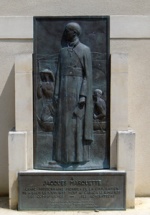
Father Marquette Monument in Laon: Commemorating an North American Historical Figure on French soil
Born in Laon, Northern France, in 1637, the Jesuit priest Jacques Marquette discovered the Mississippi River in 1673, as he explored the region alongside Louis Jolliet, the Quebec-born noble, merchant and explorer. Father Marquette died near the present-day city of Ludington, Michigan, in 1675. When his bones were discovered in 1877, he became a renowned historical figure in the United States, but remained largely unrecognized in France. The story of the monument built in 1937 in Marquette's hometown to honour this North American historical figure illustrates just how whimsical the local memory of him could be. A Jesuit long-disowned in France due to anticlericalism, Father Marquette was honoured in his home country when his historical contributions as an explorer and mapmaker were finally recognised.
-

Father Potier’s Glossary of Spoken Canadian French
The French language is without a doubt the key heritage element shared by New World French speakers. Over a period of four centuries, North American French has survived and evolved, its various dialects and accents multiplying as a result of the diverse natural and cultural surroundings in which it has taken root. Furthermore, the various cultural encounters and conflicts, as well as the occupations, vocations, and areas of expertise of its speakers have their mark on the vocabulary, the expressions and the structure of each variety of the language. One of the most important documents for the study of the history of North American French is the manuscript entitled Façons de Parler Proverbiales, Triviales, Figurées, etc., des Canadiens au XVIIIe Siècle [Proverbial, Everyday and Figurative Expressions, etc. of 18th Century Canadians]. It is a little notebook compiled between 1743 and 1758 by Father Pierre Philippe Potier, a Jesuit missionary to the Hurons of the Detroit River region. This glossary of spoken Canadian French was the first - and in fact the only - work of its kind to document the French spoken in New France. Potier jotted down most of the words of his glossary while serving in the Detroit River area, where he was a missionary from 1744 until his death in 1781. The document is therefore of great importance to the French speakers of this region.
-

Fortress of Louisbourg: from History to Historic Site
Standing on a low-lying peninsula along the north-eastern shore of Cape Breton Island, the Fortress of Louisbourg seems to rise right out of the sea when approaching by water. Coming by land along Route 22 from Sydney this picturesque complex of fifty or so buildings that appear to have survived from another era is equally impressive. Once close enough to make out the details, visitors see that the ensemble is nearly surrounded by fortifications, an 18th-century set-piece that looks as if it has been there for centuries. It hasn't, of course. For this is the Fortress of Louisbourg, a fortified town-site that is a one-fifth reconstruction of what had once stood on that very spot: the 250-buildings ville fortifiée erected by French colonists between 1713 and 1745. The goals of the ambitious Canadian reconstruction project of the second half of the 20th century, built between 1961 and 1982, were to create a major cultural tourism attraction in Atlantic Canada and to encourage interest and pride in a then little-known part of Canadian history.
-
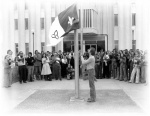
Franco-Ontarian Flag
When the Franco-Ontarian flag was raised for the first time at the University of Sudbury on September 25, 1975, its two designers, Michel Dupuis and Gaétan Gervais, preferred to remain anonymous. They wanted the flag to serve as a unifying symbol for all Franco-Ontarians without it being linked to any particular group, such as the Sudbury community or Laurentian University. Their gamble paid off. Since its creation, the Franco-Ontarian flag has been embraced as the visual emblem of the entire Franco-Ontarian community and is proudly flown at festivals, celebrations, rallies, and demonstrations throughout the province.
-

Fransaskois Music and Song
In 2006, on the occasion of the 100th anniversary of the founding of the Town of Gravelbourg, the a cappella group Octopus released its first compact disc…after 43 years of existence! Formed in 1963 at College Mathieu by Father Fernand Binette OMI, this Fransaskois group would undergo many changes and enjoy much success over the years. Its long existence, in close association with College Mathieu in Gravelbourg, is part of the history of French-language song in Saskatchewan. Singing has always played an important part in Fransaskois cultural life; it has been a means of expression, a reason for getting together, and a source of identity. Singing took several different forms over the 20th century: patriotic songs, festivals, boîtes à chansons, choral singing, and the emergence of Canadian stars like Hart Rouge. Today, while economic problems clearly exist, French-language music is still very much alive in the Fransaskois community.
-

French Prairie, Oregon
French Prairie, located in western Oregon’s Willamette Valley, takes its name from the bi-cultural French Canadian and Indian families who colonized the area in the 1820s and 1830s These French-Indian settlers served as important historical actors in Euro-American colonization of the region, which began with the overland fur trade in the 1810s. French Prairie was originally the home of the Ahantchuyuk Kalapuyans, an aboriginal people whose numbers declined precipitously during 1830s and 1840s as a result of disease and Euro-American emigration. The Willamette Valley later become the primary destination of the American Oregon Trail settlers of the 1840s. Following the eventual assimilation of the French-Indian families and the political ascendancy of the Anglo-Americans, the historical role of the francophones was often obscured in traditional texts on Oregon history. However, the history and heritage of the francophone settlers remained in the memories of their descendants. Today twenty-first century visitors to Champoeg State Heritage Area have opportunities to learn about the French-Indian settlers of French Prairie.
-

Harvesting the Stands of Eastern White Pine
In recent centuries, the forests of eastern North America have undergone drastic changes. Land clearing by European settlers and the various episodes of logging that followed have irrevesably altered the ecological course of timber stands across the continent. The white pine forests were not spared this upheaval, for they were the target of relentless harvesting that lasted over 250 years-a process so intense that the majority of the stands once populated by this precious resource have now disappeared. The logging reached its peak in the 19th century, initially in order to meet the needs of the British Navy and then to support the development of Canadian and American cities, towns and villages.
-
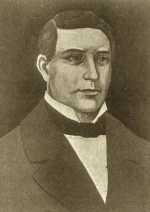
Jos Montferrand, Legendary Figure of the Ottawa Valley
Joseph Montferrand, dit Favre, better known as Jos Montferrand, is still considered one of the greatest figures of French Canadian legend. The hero is referred to by many different names across North America, including Montferan, Muffraw, Mouffreau, Mufferoin, Maufree and Murphy. While he is closely associated with the Ottawa Valley, this lumberjack, log driver, foreman, raftsman and strongman was not born and raised there. He did, however, spend half of his life in the region, drawn by the forest industry that proved to be the economic force of the Ottawa Valley in the 20th century. It was also in this region that he became a character of legend; today, there is no way to distinguish his real exploits from those that are purely folklore.
-

La Mauricie National Park of Canada
La Mauricie National Park was created in 1970 to protect and develop the rich natural heritage that characterizes the southern Laurentians. Rising from ancient bedrock, the contoured mountains are covered by vast mixed forests, dotted with nearly 150 lakes and rich in wildlife. In ages past, aboriginal peoples travelled through the region, hunting and fishing for food and, later, taking part in the fur trade. In the 19th and 20th centuries, the area was the site of intensive logging. Beginning in the 1880s, the region also became a travel destination for rich sports fishermen, with the establishment of several fish and game clubs. Today La Mauricie National Park serves as a refuge for many species of wildlife, including the Eastern wolf, the black bear, the beaver, the moose and many species of fish. Visitors can enjoy many outdoor activities in the park and discover the quiet beauty of nature.
-

Maillardville, a francophone community in British Columbia
For more than two centuries, French-speaking people have been in British Columbia. Francophone members of the Mackenzie and Fraser expeditions crossed the Rockies on the way to the Pacific. Later, voyageurs working in the fur trade settled in various parts of the province over the course of the nineteenth century. From 1909 on, the Maillardville community has been an example of the role played by French Canadians in development of the province. Several hundred of them came to British Columbia, recruited to work in a sawmill on the banks of the Fraser River east of Vancouver. At that time, Fraser Mills was a small company town surrounded by forest. Within a few years, a village including a church, a convent, a school, a post office, a police and fire station, and a number of businesses had replaced the dense forest north of the sawmill. The francophone village of Maillardville was born, and would go through many changes over the decades.
-

Maurice Richard, the Legendary Figure (part 2)
Maurice Richard (1921-2000), the hockey player, was much more than just another run-of-the-mill athlete. Nicknamed ‘The Rocket', the celebrated Number 9 of the Montreal Canadiens, has been written up in all kinds of media: magazine articles and scholarly texts, biographies and souvenir collections, short stories and folk-tales, novels and children's literature, poems and plays. Songs, comic books, sculptures, paintings, films, and television shows have also been dedicated to him. His portrait has appeared on articles of clothing and toys, as well as in all sorts of advertising. Public places have been named in his honour, for without a doubt, Maurice Richard is a Quebec legend.
-

Métis Fiddling and Dance
Métis peoples are those of mixed French and Native ancestry, often including other cultural origins as well, especially Scottish. The word came into common use in the 1800s on the Canadian prairies to describe the children of French-Canadian traders and First Nations women, largely Cree and Ojibwa. These intermarriages spawned a syncretic culture, including distinctive languages, called Mitchif, or Métchif, as well as clothing, food, and music. Central to Métis musical culture, both past and present, is a fiddle and dance tradition which reflects Scottish, French and Aboriginal roots as well as other influences. Fiddling has been so identified with Métis culture that Turtle Mountain players say, “There’s no Metchif without no fiddle. The dancin’ and the fiddle and the Metchif, they’re all the same”(NOTE 1).
-

Montreal’s Cultural Diversity Heritage
As the main point of entry for most immigrants to Quebec, Montreal, the largest French-speaking city in North America, moves to the beat of multiculturalism. Cultural communities are a major component in the identity of this metropolitan centre. However, their presence has often been obscured by the dominant French or English-language cultures. Whether it be buildings, monuments, public spaces, works of art, place names or simply the general atmosphere of certain areas, the heritage contributed by the cultural diversity of the city is very apparent. Often it delineates the neighbourhoods where various cultures live and even coexist. Consequently, cultural diversity has always been an issue of public concern both for city administrators and politicians alike and is often central in debates-particularly when it is a matter of defining what constitutes and what should constitute Montreal's urban heritage.
-

Mount Royal Park, a Precious Natural and Cultural Heritage
Between the Laurentians and the Appalachians, the St. Lawrence Plain is punctuated by a series of hills extending from east to west. These Monteregian Hills, as they are known, were formed by intrusions of molten magma over 100 million years ago. One of them, Mount Royal, dominates the largest island of the Montreal archipelago, right in the heart of Quebec's biggest city. This remarkable urban park is subject to equally remarkable protection and enhancement measures. Exploring the mountain’s rich, multifaceted heritage is a perfect way to reconnect with the natural and human history of Montreal and appreciate the charms of its natural and human landscapes, a testimony to ongoing efforts to balance nature and culture.
-

Parc national d’Oka, a natural heritage site
Parc national d’Oka not only contains Calvaire Hill, an important historical site, but is itself is located in an exceptionally rich natural environment. The geography and geology, the fauna and flora of this area have fostered human activity since prehistoric times. Efforts to protect the present territory of the park began in the early 1960s, with the creation of the Deux-Montagnes hunting and fishing reserve, soon renamed Parc provincial d’Oka, then Parc national d’Oka. This territory now covers 23.7 square kilometres and includes several ecosystems, which are the object of ongoing scientific study. This park, a sanctuary for Laurentian flora and fauna, shows the remarkable biological and geomorphological diversity of southern Quebec.
-

Parc national de l’île Bonaventure et du Rocher Percé
Perched at the easternmost tip of the Gaspé Peninsula, Percé, with its unique and awe-inspiring geology, has garnered centuries of attention. With a landscap ecomposed of sheer cliffs, a giant limestone monolith, red soil and a white cape, Percé is an awe-inspiring marriage of sea and mountains that stands out as one of Quebec's natural wonders. Percé's centuries-old human history was marked first and foremost by the fishing industry and then by the tourist trade. Furthermore, the area houses two of Canada's natural heritage crown jewels: breath taking Percé Rock and Bonaventure Island, home to the world's largest colony of gannets. Parc National de l'île-Bonaventure-et-du-rocher-Percé was founded in 1985 to ensure that these exceptional natural assets would be protected for future generations.
-
Parc national de Miguasha
Parc national de Miguasha is one of the world’s most prestigious fossiliferous sites. Thousands of fossils of fish, plants, and invertebrates some 380 million years old have been discovered there. UNESCO added this natural site on the Gaspé Peninsula to its World Heritage List on 4 December 1999. But well before being recognized as a world treasure, this site had long been a part of the daily life of the inhabitants of Miguasha who collected fossils. Indeed, these people were tremendously helpful to the scientists who began to appear in their region at the beginning of the 20th century. Scientists still take an active interest in the site, and the park’s team of paleontological researchers continue to gather new specimens from the now-famous cliff. Some of these marvellous fossils are on display in the permanent exhibition of the Miguasha Museum of Natural History located on the very site where they were discovered!
-
Parc national du Mont Tremblant
The wildnature of Parc National du Mont-Tremblant [Provinical Park] draws visitors to the region year-round. With mountains, 400 lakes, six rivers and stands of fir and pine trees as far as the eye can see, the 1,510-km2 [583 square-mile] park features broad scenic vistas of Laurentian landscape. From the time it was founded as a forest reserve in 1895 and when it was finally recognised as a national park in 2001, the park has been subject to several changes over the years, whether it be to its boundaries or its land use. Throughout the park's history, the use of its forests and wildlife has reflected the evolution of the cultural and economic values of the society that created it.
-

Place-Royale: Where Quebec City Began
Place-Royale in Quebec City is a historical and archaeological site unique in North America. Considered the birthplace of French America, it played a major role in the social and economic development of the French, and later English, St. Lawrence River colony between the 17th and 19th centuries. Beginning in the 1860s, competition from the Port of Montreal led to the decline of Quebec City’s port and, by extension, the Place-Royale district. In the 1940s, its state of dilapidation prompted plans for an ambitious reconstruction project that was completed in the 1970s and 1980s to restore its French colonial character. Archaeological excavations and historical research conducted during this period revealed the extraordinary heritage value of America’s first French city centre.
-

Pointe-à-la Renommée Lighthouse Station (Gaspé)
The Pointe-la-Renommée (Gaspé) lighthouse bears witness to Quebec’s maritime history. Beginning in 1880, the wooden lighthouse guided navigators in the region. The first maritime wireless telegraphy station in Canada was then established there in 1904. Three years later, a second, innovative light tower dominated the point. What was unusual about it? It was built of prefabricated cast-iron components. Today, the Pointe-à-la-Renommée heritage site offers visitors a representation of the fascinating history of this point and this lighthouse station. Visitors can learn about the way of life and traditions of the families of lighthouse keepers and maritime wireless telegraph operators. They will also discover that, to preserve this lighthouse, it was moved to the Port of Quebec in 1978. Later, the activism of a citizens’ committee from the village of L’Anse-à-Valleau, convinced of the importance of this key element of their heritage, led to its return to its original location in 1997.
-

Quebec’s Place-Royale, the Reflection of a City
Quebec City’s Place-Royale was entirely rebuilt between the late 1960s and the 1980s. Work undertaken on the site’s buildings was intended to bestow them with a heritage character evocative of the French Regime. The primary goal of this ambitious renovation project, funded by the governments of Quebec and Canada, was to make Place-Royale a major tourist attraction in Quebec City. In the process, it restored one of the site’s earliest functions as a symbolic city centre.
-

Royal 22e Regiment
The Royal 22e Régiment (R22R) is one the three infantry regiments of Canada's Regular Armed Forces that has its headquarters in the Citadel of Quebec City. It is a French-speaking regiment that is composed of five battalions, of which three are in the Regular Armed Forces and two are part of the Reserve Forces. The regiment took part in all major conflicts in which Canada was involved since World War I; from the peacekeeping missions of the United Nations to the campaign in Afghanistan. Today, its rich history and heritage, both tangible and intangible, is being promoted in various ways in the very heart of Quebec City.
-

Saint-Roch: Quebec City’s Urban Core is Reborn
Saint-Roch began its life as a working class quarter, the first outside Quebec City’s walls. For many years the most prosperous and populous part of the city, it was also home to much of the francophone community. From the mid 19th century to the late 1950s, Saint-Roch was Quebec City’s commercial, industrial and manufacturing centre. Today, with its rich architectural heritage and creative, resourceful population, Saint-Roch is the living legacy of four centuries of urban history, a testimony to the massive effort to save, restore, and bring new life to the city’s urban core.
-
The Augustinian Monastery of Quebec
In 2000 the Augustines de la Miséricorde de Jésus religious community decided to assemble the archives and collections from their twelve monasteries under one roof and to make this treasure trove of information available to the public as part of the Graven In Our Memories project. The Augustinians opted to exhibit their heritage at the Hôtel-Dieu de Québec monastery, built in Quebec City’s Upper Town in the years after the first members of the order arrived in 1639. The Lower Town premises of Hôpital-Général de Québec—which also date back to the 17th century—will be integrated into this heritage complex, to be known as Monastère des Augustines (the Augustinian monastery).
-

The Cathedrals of Saint-Boniface
Since 1818, six churches have stood in succession in Saint-Boniface, Manitoba testifying to the longstanding French and Catholic presence in western Canada. The Red River town—now a borough of Winnipeg— grew by leaps and bounds over its first fifty years, from the humble Saint-Boniface Mission to the seat of a vast archdiocese covering most of western Canada. This growth led to the successive construction of five cathedrals. The largest and most prestigious, completed in 1908 under second Archbishop Adélard Langevin, was destroyed by fire in 1968, to the dismay of the francophone population for whom it was a symbol of strength. Today’s cathedral, consecrated in 1972, stands within the great edifice’s ruins, preserving the heritage value of a site that strongly symbolizes the francophone presence in western Canada.
-

The Chemin du Roy between Quebec City and Montreal
Today the Chemin du Roy, or King’s Highway, is a well known heritage route. Motorists along the north bank of the St. Lawrence River between Quebec City and Montreal can take Highway 138, which follows the approximate path of the original King’s Highway. Along the Chemin du Roy tourist route, blue signs guide drivers from town to village among the region’s heritage buildings and landscapes. Avenue Royale—which is a continuation of the original Chemin du Roy east of Quebec City—is yet a further occasion to visit and take in several additional heritage treasures. But the original King’s Highway, which was the first road to link Quebec City with Montreal was built in 1734. Along its winding course one can discover a condensed history of transportation in the St. Lawrence Valley.
-
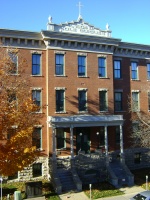
The Guigues Elementary School in Ottawa
In front of the old Guigues elementary school in Ottawa, two historic plaques, one erected by the City of Ottawa and the other by the Ontario Heritage Trust, bear witness to the epic battle Ontario francophones fought to save their schools and conserve French as a language of instruction in their province. The plaques serve as a reminder that the Guigues elementary school was at the heart of a movement to protect minority rights in Ontario at a time when, in 1912, a provincial directive commonly known as Regulation 17 ordered that French-language education be limited to the first two years of elementary school. An outcry of protests, notably at the Guigues elementary school in 1915-1916, forced the government to soften its policy and, in 1927, bilingual schools were officially recognized in Ontario.
-

The Montreal Olympic Stadium Complex
Unique in all of North America, the bold architectural style of the Montreal Olympic Stadium makes the building’s architecture one of the emblems of the City of Montreal. Designed by the French architect Roger Taillibert, in order to host the 1976 Summer Olympic Games, today the building has not only become a part of the architectural heritage of metropolitan Montreal, but also of the Province of Quebec and of Canada. Even though the general populace has a special affection for this piece of organic and sculptural architecture—which testifies to the international significance of an event that marked the rising of modernism in the Province of Quebec—many facets of the story how it was built and its short, but varied history remain unknown.
-
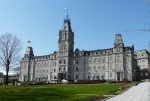
The Parliament Building of Quebec: A Place of Memory
Erected between 1875 and 1886, the Quebec Parliament Building stands as one of the finest examples of Quebec’s architectural heritage. Its craftsmanship and style evoke the past, present and future of a nation committed to democracy. And its imposing freestone façade, distinctive silhouette and interior design all bring to mind—as its architect Eugène-Étienne Taché intended—the French origins of this North American nation. The building’s east-facing façade, just a stone’s throw from the fortifications of the Old City, is adorned with a series of sculptures that hearken back to significant events and figures in the founding of Canada and Quebec. Carved above the main entrance is Quebec’s motto, “Je me souviens.” A reference to Quebec’s evolution since 1534, the motto actualizes political history and reminds observers that to this day the parliament is the seat of the people’s assembly and their elected government.
-
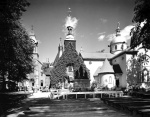
The pilgrimage to Our Lady of the Cape Shrine, Quebec
The largest North American pilgrimage site dedicated to the Virgin Mary is located at Cap-de-la-Madeleine in the Trois-Rivières region in Quebec. While the site itself has had religious significance since the French regime, the Sanctuaire Notre-Dame-du-Cap (Our Lady of the Cape Shrine) was consecrated in 1888, after two extraordinary events attributed to the Virgin Mary. The site, visited by many pilgrims every year, received its most illustrious visitor in 1984: Pope John Paul II. Despite the decline of religious practice in Quebec, the Shrine remains a unique meeting place for visitors and pilgrims of all ages and all ethnic origins.
-
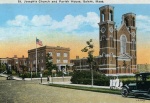
The Point: a Franco-American Heritage Site in Salem, Massachusetts
Salem, Massachusetts is a cultural palimpsest, a geographical space that bears traces of communities of people who have called this city their own. French-Canadians, who immigrated to Salem in the late 19th and early 20th centuries, made their mark in a neighborhood called “The Point.” A devastating fire razed the neighborhood in 1914, forcing its French-Canadian and Franco-American inhabitants to reimagine and rebuild it. One hundred years later, the Point was named to the National Register of Historic Places in the United States due to the uniformity of its architectural style and its cultural importance to Salem’s Franco-American community.
-

Van Horne Mansion (1870-1973): a Demolition That Changed the History of Heritage Preservation
Heritage enthusiasts looking for the Van Horne Mansion on rue Sherbrooke in Montreal will be disappointed. On the land where it was built during the middle half of the 19th century now stands a17-floor skyscraper. However, what is important about the Victorian-era home is not so much its material value, but rather the debate that surrounded its demolition in 1973. It was a moment that marked the city's transition to a modern metropolis and it changed the way people thought about their past and their future. It was a time that solidified the role of heritage conservation organisations and transformed people's idea of what constituted heritage in Quebec.
Images
-
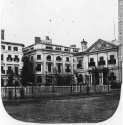
Le square de la Douan
e en 1859. Phot... -

Le square de la Douan
e en 1859. Phot... -

Manifestation d'écoli
ers contre le R... -

Le square Marquette à
Laon. Le monum...Article :
Father Marquette Monument in Laon: Commemorating an North American Historical Figure on French soil
-

Palais de glace au Do
minion Square, ...Article :
The Regional Festivals of Quebec -

Église Notre-Dame-De-
Lourdes, située...Article :
Maillardville, a francophone community in British Columbia -
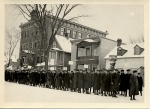
School children prote
sting against R...Article :
The Guigues Elementary School in Ottawa





